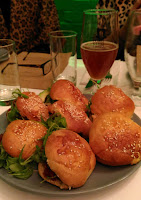Instead, let’s start the following day, with the British Guild of Beer Writers’ annual dinner. A team of four had worked together on curating the menu. One of them told me some of the staff of the hotel where we had the dinner had joined in too, but to learn rather than advise, as they don’t do this kind of thing routinely – indeed, one reason for running these events outside the ‘beer world’ is to evangelise.
 |
| Modus Operandi |
The top pairing was the main course: roasted duck breast with roasted salsify, celeriac and orange sauce, matched with Wild Beer’s Modus Operandi, a complex and fascinating sour red ale. This was also the course with a veggie alternative – roasted aubergine and salsify, again with orange and celeriac (among other things!), but partnered instead with Wimbledon Brewery’s Quartermaine IPA.
Of course, everyone simply had to try both beers “just in case”, and yes, the toasty-crisp and malty-bitter Quartermaine could have gone well with either, but didn’t go as well with the duck as the Modus did, while the Modus overpowered the roasted veg. So, great choices there.
 |
| Dark Side of the Moo |
The cheeseboard also brought a less traditional pairing – rather than a Barleywine, or perhaps an ESB, they went for a richly-hoppy and fruity-dry American-style IPA, namely Fourpure’s 6.4% Shape Shifter. And it worked well – the earthy hoppiness, with its fruity and onion skin notes, cut through the creaminess of the cheddars and the other cheeses.
 |
| Beer rack at Borough Wines Hackney |
This time, the menu was all about showing how well a good London-brewed beer can work with spicy food – well, after an introductory beer cocktail. Featuring grapefruit, lemon, elderflower liqueur and Pilsner, this was tasty yet the beeriness was rather low-key. Beer cocktails have been popular in some places for many years, has their time come in London?
 |
| Alt & savoury brioche |
Next up was a sort of daal, made with tarka beans and accompanied by Beavertown’s collaboration The You Zoo. The latter is an IPA which at 7.5% verges on the Double, and features two ingredients that have been very fashionable among edgy brewers in recent years – yuzu, which is a citrus fruit, and tea, in this case Formosa Oolong. To my surprise, it was the food that expanded the beer here, with the daal bringing out the beer’s fruity bitterness.
 |
| Yuzu IPA & daal |
So yes, IPAs and bitters do indeed go very well with spicy food, which makes it doubly frustrating that most curry houses have such crap beer lists.
Also frustrating though were my own attempts to do beer and food matching over the holidays. I think part of the problem was that I was trying to match to foods I’d not yet tasted, because we hadn’t finished cooking and they were stuff we’d not cooked before. It’s salutary to recall that in both these cases, the ‘curators’ had worked with samples of both the beers and the menus. You can do a lot with guesswork, but you really need a taste to work with. Ah well.
And on that note, I wish all my readers a Happy New Year, full of excellent beer and food. May your bottles never gush and may all your bars be beery ones!
 |
| Beery types behind bars |
